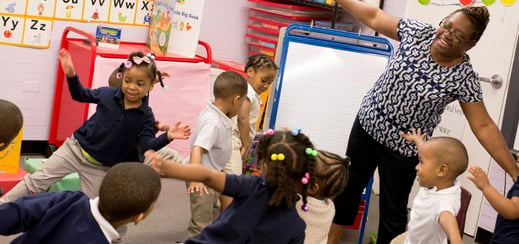
Teachers, what is your reaction when someone talks to you about using CLASS? Do you cringe, thinking of a numerical score? Do you feel overhwlemed, trying to imagine yet another new thing for you to learn about and do in the classroom?
The good news is the CLASS tool is really about enhancing interactions you are likely already doing in your classroom. The CLASS tool gives names to interactions and extends what we already know as good practice for teachers and children.
Let’s look at a couple of scenarios that might take place during a regular day in the average classroom and break down the interactions into CLASS domains in order to help you see more clearly that what you do counts and encourage you to multiply the impact of your daily interactions.
Emotional Support:
Ms. Mary sets up her classroom so the children have lots of interesting choices for center time. Children are able to choose where they want to work, which materials to use, and how to use them. During work time, Ms. Mary makes her way around the room giving the children smiles and a “thumbs up,” providing verbal or physical help when needed, addressing problems, and acknowledging children’s work as she goes.
Multiplied: As Ms. Mary circulates the room she stops to talk with individuals or groups of children about what they are doing, eliciting children’s ideas and points of view. Children feel comfortable sharing their thoughts with her because she shows genuine interest in their efforts. She encourages the children to talk with one another about their work, and facilitates cooperation and peer assistance.
Classroom Organization:
Mr. Luis calls the children to story time and waits briefly as everyone gets settled on the carpet. He asks the group to recall the rules for story time before he shows the children the book “Time to Sleep,” which he has ready in his lap. He redirects those who are still learning the routine. He asks the children to participate by snapping their fingers each time they hear the word “sleep” in the story.
Multiplied: Mr. Luis invites the children to join in a tap-clap pattern as they settle themselves on the carpet for story time. The children know where they are to sit and do a self-check to make sure they are ready for the story, following a well-established routine. He presents the cover of the book with a sleeping bear and reads the title, asking the children, “Why do you think this book is called 'Time to Sleep'”? He talks about sleep with the group and passes a card to each child with the word “sleep” written on it, reminding the children to listen for that word and hold up their cards each time they hear it. He begins to read the story.
Instructional Support:
Ms. Char sits at the table with 7 children as they all eat lunch. She talks to the children about the foods in today’s lunch, and asks them if they eat corn at home.
When several children respond that they do, she asks them how it is served at their house. She scaffolds with words like “mixed” or “mashed” or “on the cob” and explains what those words mean. She describes how children are eating by saying, “I see that Christopher is eating his corn with a utensil” and “Alicia, you are wrapping your corn in your tortilla.”
Multiplied: As they eat, Ms. Char asks the children to think about how corn is grown and asks if anyone has ever seen corn growing. During the discussion, she helps the children understand the concepts of “stalk”, “husk,” and “shucking” through extended back-and-forth exchanges and open-ended questions. She asks if the children remember their trip to the grocery store where they saw corn on the cob being sold. She encourages them to brainstorm why they think the corn grows that way. The children then ask if they can plant some corn seeds and together they decide to continue learning more about corn and how it grows.
Most likely, you already see yourself in many of these interactions and recognize the numerous ways you can multiply what you do to help children get the most out of learning opportunities. As teachers we can choose to enrich everyday activities to acknowledge, engage and inspire our children in the learning process. What effective teaching strategies will you use to intentionally multiply the impact you have on your children’s learning?

